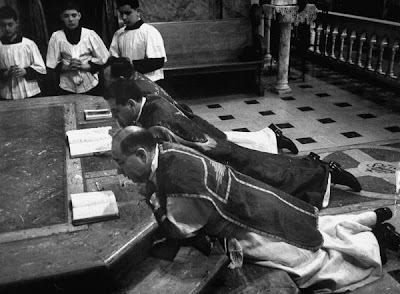Throughout the Lenten season, the Church has prepared us step by step for the sacred experience of the drama of Holy Week. A steady crescendo has been taking place since Septuagesima Sunday. Not until now has the Church unveiled the mystery of the Cross and resurrection, which were given us up to now only in figures and signs.
Now, with Holy Week, the curtain is lifted, we see the Holy of Holies. And, not only do we see but we are asked to participate in the most sublime drama of history.
The great week is about to begin – starting with Palm Sunday. Rather than a week of mourning, it should be called the redemptive week, in which the work of redemption terminated in victory, for Cross and resurrection are intimately united.
Holy Week can be summed up in the words of St. John’s from his Prologue: “The light shined in the darkness, and the darkness grasped it not.” Darkness struggles against the light of Christ’s revelation as against an enemy; but to those who receive it, Christ gives “the power of becoming sons of God.” And as the mystery of darkness (the devil is the prince of darkness) and light (Christ the truth) unfolds during the Sacred Triduum, the same clashes takes place on another vein, death and life fight in a mortal duel, which will conclude with Christ the Life giving the death blow to Death by His own passing.
Life is given Him through death: Christ the man rises from death to die no more since His sacrifice was accepted by the Father and He merited for Himself and all His followers a glorified body joined to a soul enjoying the beatific vision. Thus the ancient symbol of Christ, phos-zoe (light-life) serves well as a caption over this great week of grace.
Another important aspect of the Christian life is taking a prominent place during the Holy Week’s liturgy: the reception of converts into the Church. In olden days, the Lenten season marked the preparation - both moral and doctrinal - of the catechumens to the great step of baptism, reflected in many ceremonies. The catechumens passed their last examinations earlier on in Holy Week. On Maundy Thursday, there was the reconciliation of the public penitents making up for their public sins. They would be formally received in full communion and allowed to approach the sacred table on Easter Vigil.
On the same day, the holy oils were blessed by the bishop, which would be needed for the Baptismal ceremony. Easter Vigil is replete with the ceremonies addressed to catechumens who are to be formally received into the Church. The long lessons from the Old Testament serve as a last minute catechism, the baptismal water is blessed and the baptismal promises are pronounced by all the faithful present, but especially by the candidates to baptism, which takes place at that time.
The Easter Vigil, which formally lasted the entire night, was the vigil of the catechumens as much as it was the celebration of Christ’s rising from the tomb. Both activities are one in the mind of St. Paul:
We have been baptized (submerged) in Christ’s death and risen (drawn out of the water) in Christ’s resurrection.
It is highly recommended that the faithful free themselves from the worldly worries and dedicate what time they can to the meditation and contemplation of the sacred mysteries. One of the best ways is simply to go over the liturgical texts which reach a degree of intensity never achieved in the other seasons of the year.
Source: SSPX Pastor's Corner
Past Posts on the Triduum:
- Top Ten Suggestions for Holy Week
- Holy Thursday
- Holy Thursday: Plenary Indulgence
- Good Friday
- Good Friday Prayer
- Easter Proclamation
- Holy Saturday










0 comment(s):
Mag-post ng isang Komento